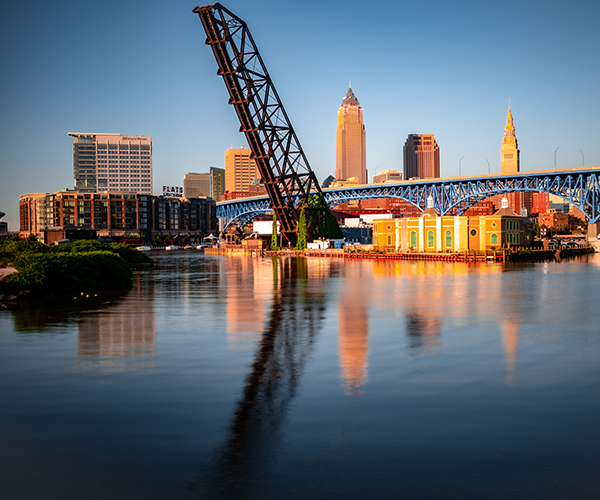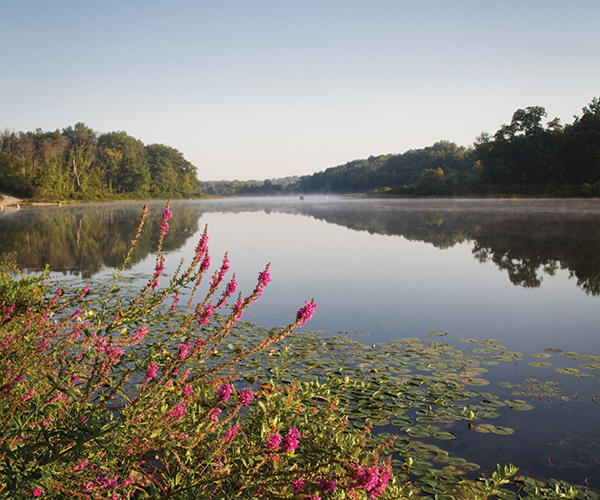The river burned.
Three years later, in 1972, Lake Erie's health didn't look much better.
Sewage treatment plants and agricultural runoff had packed the water with too much phosphorus. The plant nutrient accelerated algae growth at an alarming rate, leading to a biological meltdown that killed fish, closed beaches and prompted the federal government to step in and mandate cleanup measures for Ohio's most valuable natural resource.
The Great Lakes Water Quality Agreement of 1972, amended in 1978 and 1987, stemmed the flow of pollution by limiting the amount of phosphorus that could be legally discharged into the lake. Gradually, the water lost its sickly brown cast. By the mid-1980s, Lake Erie was cleaner than it had been since phosphorus levels first began to rise following World War II.
Boaters shoved out onto the lake in higher numbers. (Today, 30 percent of licensed Ohio boaters — roughly 65,000 households — name it as their primary boating destination.) People returned to Ohio's beaches and Lake Erie was once again deemed healthy.
As the '90s progressed, however, the pendulum started to swing again.
|
Lake Invaders Here's a closer look at five exotic species that have infiltrated Lake Erie's ecosystem. By Richard Rainey Sea Lamprey (Petromyzon marinus) With its tooth-lined sucker of a mouth, this eel-like parasite invaded Lake Erie from the Atlantic Ocean on the backs of fish swimming up the Welland Ship Canal. First noticed by fishermen in 1921, lampreys are partially blamed for the extinction of the lake trout population in Lake Erie during the 1950s. Methods to fight the lampreys' spread range from setting traps to using chemicals to sterilizing as many of them as possible. These programs have significantly diminished the number of lampreys throughout the Great Lakes, leading to a promising future for larger fish. Spiny Water Flea (Bythotrephes cederstroemi) After being deposited in Lake Huron sometime in 1984, this tiny crustacean made its way into Lake Erie about three years later. A distant relative of lobster and shrimp, the spiny water flea is only half an inch long and feeds on the microscopic plankton in lake water. Biologists believe the first water fleas hitched a ride in the ballast of a freighter coming from the Eastern Baltic Sea — possibly from Finland. It is still unclear what its ultimate impact will be on Lake Erie's ecosystem. Zebra Mussel (Dreissena polymorpha) Arguably the most infamous Lake Erie invader, this small gastropod has attached itself to nearly every underwater surface. First detected in 1988, the Lake Erie zebra mussel population seems closely related to those found in the Netherlands and Poland. Though they have been blamed for contributing to the dead zone in the lake's central basin, they are voracious eaters of microscopic morsels and have aided the clearing of Lake Erie's waters. Quagga Mussel (Dreissena bugensis) First recognized as a separate species in 1991, these thumbnail-sized clams are hardly distinguishable from their cousins, the zebra mussels. Quagga mussels' shells are slightly lighter in color, and they prefer colder and deeper water. Last year, they outnumbered zebra mussels 10 to 1. This means that, combined with zebras, these mussels could easily coat the entire bottom of the lake if left unhindered. Round Goby (Neogobius melanstomus) Native to the Black and Caspian seas of Eastern Europe, this bug-eyed invader somewhat resembles a monstrous tadpole. The fish were first detected in Lake Erie in 1993, two years after a ship dumped them into the St. Clair River while emptying its ballast tanks. Gobies are highly territorial and voracious eaters, which gives them a distinct advantage when competing with native lake species. They feed mostly along the lake bottom, scrounging up enough eggs and small fish to grow up to 10 inches in length. |
"The lake itself is in a state of flux," explains Frank Lichtkoppler, a biologist and district specialist for the Ohio Sea Grant program's Lake County office. "We ignore the problems of our lake at our own peril. That's what we did in the '70s."
Lake Erie is still far from those dark days. Federal legislation approved in the past year aims to make sure it never reverts to that state, while researchers scramble for a shrinking pool of cash to further study the metamorphosis of Lake Erie's ecosystem.
Some say that fresh concerns about the lake's health may have a common catalyst. Time and grant money will tell for sure. What's certain is that scientists studying the lake are looking for causes aside from pollution at the hands of humans.
This time around, experts say, the problem may not be what's being dumped into the lake, but what's living in it.
Nothing that needs oxygen to live can survive there. Walleye and perch flee to more favorable waters. Even insect larvae and worms suffocate. Such an area is casually referred to as a "dead zone" — a portion of Lake Erie's central basin just off the Ohio shoreline that slowly becomes devoid of oxygen each summer.
A dead zone forms as climbing temperatures divide the lake into two layers, cutting the bottom waters off from the atmosphere. Decaying algae gradually leeches all oxygen from this cooler, deeper layer.
While it's a natural occurrence, problems arise when a dead zone grows too large, too fast, as one did in the '70s. Last year, the Environmental Protection Agency's Great Lakes National Program office once again raised the red flag.
"They started looking at some of the monitoring data and said, •There's a problem here. The lake seems to be getting worse,'" recalls Gerald Matisoff, Ph.D., a professor at Case Western Reserve University who was one of 27 scientists invited by the U.S. EPA to study the dead zone aboard its research vessel last summer. The EPA may return to Lake Erie for one week this summer to conduct follow-up tests.
The formation of a larger or longer-lasting dead zone is an early indicator that water quality is worsening. Traditionally, phosphorus accelerates algae growth and, consequently, increases the size or duration of dead-zone phenomena. Matisoff, who spent three weeks working with the EPA, now says those rules about Lake Erie's ecosystem no longer seem to apply. The direct link between increased phosphorus levels and algae growth seems to have been severed.
"Even though we're seeing larger amounts of phosphorus in the lake than we used to, we're actually seeing lower concentrations of algae in the water," he says.
Understanding the dead zone is crucial because degrading water quality comes with a variety of unpleasant results. Fish can't live in the waters, so the food chain breaks down. Secondly, though oxygen-breathing organisms cannot live there, bacteria and other anoxic organisms thrive. Many spew noxious chemicals in their waste that further sour water quality.
"Remember how when you turn on your faucet in August it's always kind of smelly?" asks Matisoff. "That's one of the undesirable consequences of this low-oxygen water that happens naturally towards the end of the season."
So, if it's not algae fueling the dead zone's expansion, what is the cause?
"There is something going on out there we don't understand," Matisoff acknowledges. The most popular theory ties the oxygen deprivation not to dying algae, but the decomposition of a different sort of organism — tiny water-filtering mussels native to Eastern Europe and no larger than a U.S. quarter.
More than 150 "exotic" species — non-native invaders to the ecosystem — live in Lake Erie. A handful, the most harmful of the lot, gets the most attention.
In 1921, the sea lamprey invaded the Great Lakes, wreaking havoc on native fish populations. The eel-like creatures, which predate the dinosaurs, are parasites that latch onto fish with a disc-shaped mouth filled with rows of teeth. Large fish usually survived the attacks. Smaller fish died immediately or were killed by fatal infections from the open wounds.
There have been plenty of other invaders since then. The best-known to people living along Lake Erie is the zebra mussel. First discovered here in 1988, they seemed to take over the entire lake bottom. Zebra mussels wiped out the native Lake Erie clam population, which once fed a thriving freshwater pearl industry, by latching on to the top of their shells. As the mussels piled up, the clams could no longer open their shells under the weight and died. Eventually, predators of the zebra mussel, such as the round goby — a gray fish with black and brown blotches that measures an average of 10 inches long and dwells on the lake bottom — became fixtures of the ecosystem as well.
Today, the genetic diversity of Lake Erie more closely resembles what one would expect to find in Europe's Black Sea than a North American Great Lake. That's because many species were transported here, researchers say, in the ballast water of intercontinental trading ships. When ships discharged ballast water in port, non-native species were released into the Great Lakes. Those that found an ecological niche survived. Plenty did.
"We think the Great Lakes may be having an invasional meltdown because they are very young ecologically," explains Carol Stepien, Ph.D., a fisheries geneticist and professor at Cleveland State University. "They have only been here since the last Ice Ages [about 14,000 years], which seems like a long time ago to a layman. But, in terms of biology and geology, it's not a very long time."
The presence of the zebra mussel, which is quickly being supplanted by the genetically similar yet smaller, rounder and heartier quagga mussel, is a leading theory as to why the dead zone is growing. Matisoff says, "The most popular hypothesis seems to be that zebra mussels or quagga mussels have modified the nature of carbon and phosphorus cycles in the lake."
As these tiny organisms die off and decompose, the theory goes, they give off carbon that saps oxygen from the lake. So far, it remains just a theory.
There are other changes spurred by the invading mussel population that would seem to benefit Lake Erie, but don't. For example, the lake's bottom water is visibly clearer than it has been in decades due to its being filtering by zebra mussels. The problem, Stepien says, is that the native walleye population prefers swimming in dark, murky bottom waters. Consequently, walleye populations have dipped a bit in recent years. Perch, on the other hand, use the ubiquitous gobies as a food source.
"We try to preserve what we can of our native species," Stepien says. "But once you put in a lot of foreign species like we have in Lake Erie and the other Great Lakes, it's a whole different ballgame."
Unraveling the rules of that game is now the biggest challenge facing researchers.
Scientist Robert Heath, Ph.D., does not believe zebra mussels are solely to blame for the changes going on beneath Lake Erie's surface. His research does show, however, that the organisms can be linked to the growing dead zone in the central basin and microcystis outbreaks documented in the lake's western basin.
Heath, a biogeochemist and director of the Water Resources Research Institute, says he believes changes to Lake Erie's food web at a microscopic level are the real reasons behind some of the recent trouble. When one starts examining the cause of such changes, though, it's not long before the trail turns back to the lake's zebra and quagga mussels.
For example, the noxious, bacteria-based microcystis blooms seem to be fueled, at least in part, by the way the mussels interact with the Lake Erie ecosystem, according to Heath.
"What my research has found in the past is that in the region where there are zebra mussels there can be sufficiently high concentrations of ammonium and phosphorus to stimulate blooms of things like microcystis," he says.
Heath agrees that the expanding dead zone is most likely linked to the increased carbon from decaying mussels.
"We don't know for sure," he cautions. "But it could be."
Scientists also point to lake invaders such as the zebra and quagga mussels when it comes to pinpointing a cause for the thousands of bird and fish deaths linked to naturally occurring botulism over the last three summers. The working theory is that these non-native organisms allowed such deadly bacteria to infiltrate the lake's food chain in the first place.
Zebra mussels attach to hard surfaces on the lake bottom and filter plankton from the water. The water appears cleaner, but any pollution filtered out of the water remains in the mussels' tissue. Though they filter particles from the water, Matisoff explains, smaller particles such as cyanobacteria, which spurs microcystis, pass through them.
"There is evidence that all the birds that are dying are diving ducks," Matisoff says. "They are diving and feeding on the bottom in areas where the zebra mussels and quaggas are spitting out all their junk. The botulism bacteria can survive in that sort of noxious goop."
Even though exotic species have transformed Lake Erie's ecosystem drastically during the past decade, there is reason to believe the worst is over, Matisoff says.
"Essentially, the walleye behaved as though it was a non-indigenous species during the 1980s," he explains. "The population exploded, but [the walleye] behaved as though it was an invader. Now its population is more stable. That's what we suspect will happen with all the other species that are invaders as well. The population will explode, but then it will stabilize itself."
While the public may view protracted scientific debate about the health of Lake Erie as unnecessary hand-wringing, it's clear the federal government does not. In the past 12 months, Congress voted to spend millions of dollars to clean up the Great Lakes and protect them from being overrun by new exotic species.
The Great Lakes Legacy Act, co-introduced by Sen. Mike DeWine and passed last November, earmarks $34 million for Great Lakes cleanup efforts, including the removal of sediments at the mouths of the Ashtabula, Huron, Black and Cuyahoga rivers.
The National Aquatic Invasive Species Act of 2003 set aside $150 million over the next five years to minimize the introduction of non-native species to the Great Lakes watershed. In April, Sen. George Voinovich co-introduced the Lake Erie Dead Zone Bill to study freshwater ecosystems.
The move was important for Lake Erie researchers because, when research dollars are doled out to scientists, those who study ocean ecosystems seem to have the edge. The U.S. EPA only has the resources to conduct in-depth studies of each Great Lake once every five years.
"There is a definite prejudice against the study of fresh water," Matisoff says. "We have to explain why doing something in the Great Lakes is beneficial to the study of the oceans, but they don't have to explain why study of the oceans is beneficial to understanding the Great Lakes."
Unfortunately, the money available to study United States' coastal and freshwater ecosystems is an ever-shrinking pie to divide. Sea Grant's 2003 national budget was cut from $103 million to $63 million.
"Everybody gets cut," Lichtkoppler says, adding that 27 individual Sea Grant programs faced budget cuts, while just three held on to their initial allocation. "Financing is a big concern."
Considering that 11 million people rely on Lake Erie for drinking water every day, ensuring its long-term health is crucial. Couple that with the fact that the lake injects $1.5 billion into local U.S. and Canadian economies and the importance becomes even clearer.
"The goal is to have a lake that is swimmable, drinkable and fishable," Heath says. "And those three pillars of lake water quality are really tall pillars in Lake Erie. Really strong pillars."
Lake Erie's resilience may prove to be its biggest handicap when it comes to garnering sympathetic ears that can free up cash for future research. Because as long as people can fish and swim in its waters, Lichtkoppler says he believes most people will forget there are unanswered questions as to what is happening to the lake on a biological level.
"It has to be almost a crisis situation before people react," he says. "And that's too bad. Because at that point the cost to fix the problem has risen."
Trending
-
1
-
2
-
3
-
4
-
5










